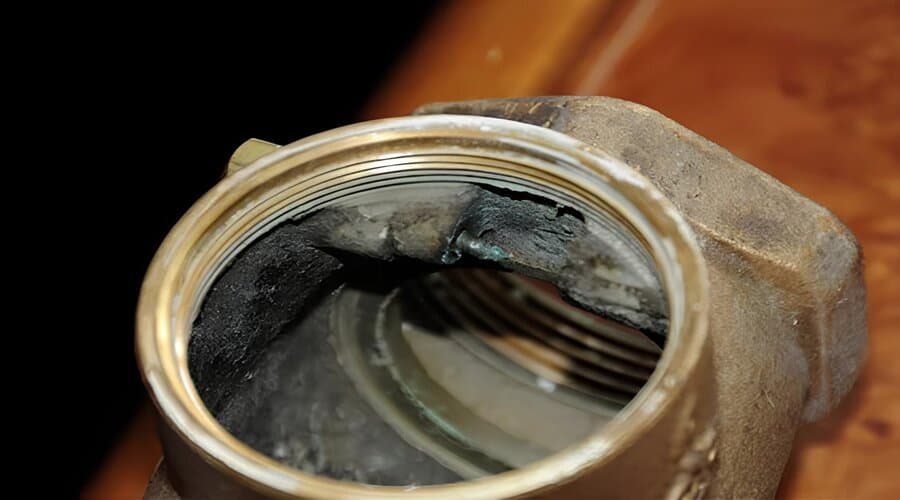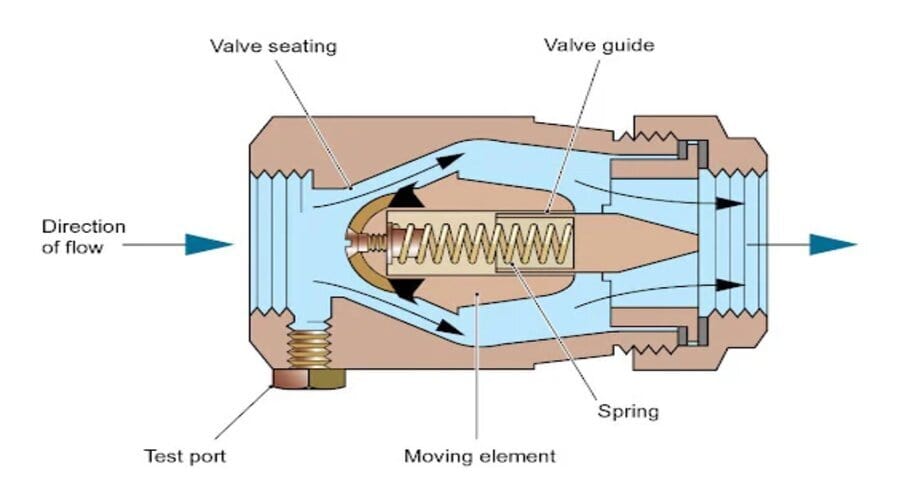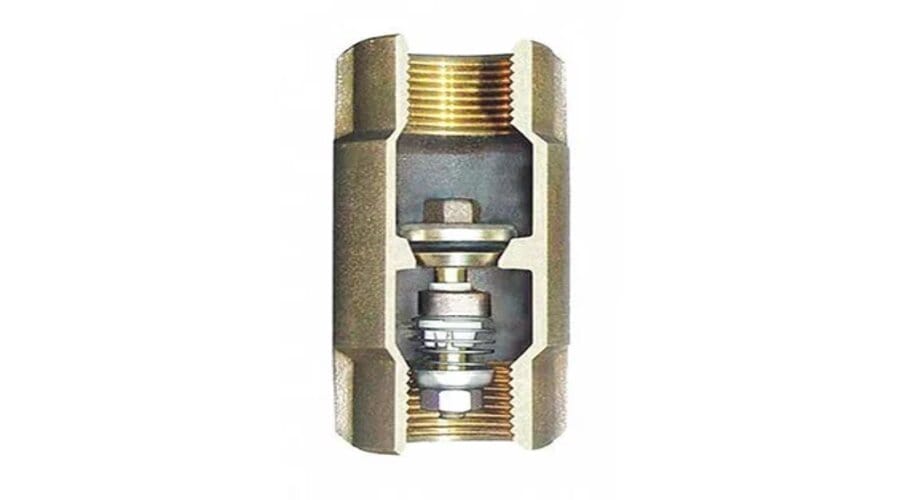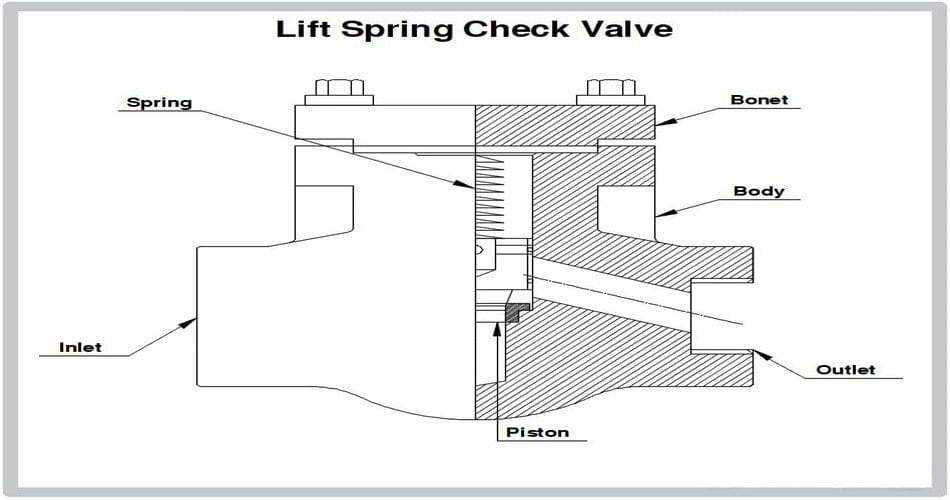What Is Check Valve

Figure 1. Check valve failure and solution
Check valves, also called one-way, retention, or non-return valves. It allows the material to flow in one direction. If fluid enters one of the two openings of the check valve, we call it the entrance. If fluid exits the valve through the other opening, we call it the outlet.
Check valves stop backflow and prevent fluid from flowing backward through the system where they are installed. You should use these rules when fluid release could contaminate the fluid entering the system. Since this is the case, a broken well check valve could cause oil to flow back into the well.
Types of Check Valves
Understanding the types of checks before exploring the symptoms of a bad check valve is important.
- Check Swing Valve
Swing check valves obstruct the flow using a disc mounted on a hinge or trunnion. To prevent reverse flow, the disc either detaches and seats or retracts to permit forward flow. While available in various sizes, they are typically quite sizable. A swing check valve is demonstrated by the flapper valve found in toilets. The water pressure maintains the position of the valve until it is moved manually using a lever.
- Stop Check Valve
This valve features an override control that can halt flow irrespective of pressure or direction. Furthermore, apart from impeding backflow or forward pressure below average, these can be sealed by an external mechanism that obstructs all flow irrespective of pressure.
- In-Line Check Valve

Similar to a lift check valve. These are defined by the presence of a spring that rises in response to pressure upstream. When the “cracking pressure,” the force required to surmount the spring tension, is reduced, the spring automatically repositions the lift.
Diaphragm Check Valve
A flexing rubber diaphragm is positioned to create a closed valve. For the check valve to open, the pressure on the upstream side must be greater than the pressure downstream. Upon cessation of positive pressure, the diaphragm flexes back to its initial closed state.
Lift Check Valve
The lift check valves utilize a disc called the “lift,” which is propelled from its seat by the elevated pressure of the inlet or upstream fluid. Subsequently, the fluid proceeds downstream. The lift’s trajectory is maintained vertically and aligned by guides to ensure correct reseating. The lift will be reseated by gravity or higher downstream pressure once the pressure decreases.
Ball Check Valve:
The ball check valve is a prevalent type of valve that employs a ball as its closure element. The ball of certain types of valves is spring-loaded to assist in keeping it closed.
To form a seal, the ball must be moved by reverse flow without a spring. Ball check valves are compact, primitive, and inexpensive. They are frequently found in sprinkling nozzles and spigots.
Types of Check Valve Failures

Figure 2. Check valve failure
Although the signs of a malfunctioning check valve differ from machine to machine, there are some commonalities that you should be aware of.
Simple mechanisms valves are continuously used. Any frequently used object will degrade and finally become inoperable.
When designing the system, position the valves in a location that facilitates easy access and replacement by using appropriate maintenance procedures and closely monitoring the components. It is possible to avoid any failures, interruptions, or periods of inactivity.
- Flow Fluctuations and Disruptions
We implement valves to maintain a consistent and constant passage of gas or fluid. They ensure the valve will restrict the flow to meet the parameters, regardless of the set point or desired pressure.
Valves that malfunction give rise to flow variations, manifesting in the outcome. A failure of a bad check valve can result in an inadequate or excessive gas supply to the patient. To avoid problems, you should regularly maintain machines and replace faulty valves.
- Reverse Flow
Reverse flow is an extremely prevalent and potentially expensive valve issue. The purpose of valves is to restrict the passage of fluids or gases in a single direction. Constantly, the substance flows from upstream to downstream.
When something blocks or stops the flow, the material returns to its original location. This may result in the pump malfunctioning if it induces a reverse rotation during discharge. A shut-off valve that closes quickly and securely will prevent this from occurring.
- Water Hammer
Another frequent issue that can arise with check valves is the water hammer. A water hammer happens when a check valve abruptly changes direction or stops moving. This causes an increase in pressure in a liquid or vapor.
A valve closure causes this in pipeline systems or along the flow path. The water hammer of the check valve induces vibrations and striking sounds throughout the system. They are preventable with check valves that close more quickly, halting surges and shock waves.
Causes of Check Valve Failure
A failure check valve can cause catastrophic consequences when operating liquid handling equipment. Learn the causes and warning signs of impending valve failure to avoid valve failure and expensive repairs. Significantly, check valves are maintained if you operate a system that utilizes piping to transport fluid. By opening and closing in retort to hydraulic pressure, check valves to ensure unidirectional fluid flow and prevent reverse flow. The leading causes of check valve failure are as follows:
From YuDaMan
Inadequate Maintenance
Consistent maintenance is a guarantee of protection against valve failure. Check the pipeline for dirt and signs of damage. Small pieces may become stuck in the valve, damaging the inside parts. As soon as you observe any indications of deterioration, replace your valves.
Higher Temperature
Check valve failure can occur in applications that operate at elevated temperatures, and it is imperative to note this. Inspecting the check valves and substituting them upon perceiving any sign of wear is imperative.
Inverse Stream
When water rushes upstream of the check valve, reverse flow occurs. If this happens while the pump runs, it can be extremely dangerous and costly. It can cause the pump to spin in the opposite direction, which leads to gradual damage. To mitigate this issue, verify that your valve is operating by ensuring that it closes quickly and securely.
Installation And Assembly Failures
Installing or assembling valves creates the basis for potential complications in the future. The application installation and selection of the appropriate check valve size are paramount. Properly installing the check valve can avoid premature valve failure.
Faulty Check Valve Symptoms

Figure 5. Spring check valve
Failures of check valves can result in irreparable harm to the valves and the pipelines. However, these signs exhibit indications that, when detected and treated, could avert severe harm. The symptoms of check valve failure are as follows.
High Energy Consumption
High energy expenses may serve as an indication of faulty valves. The elevated expenses result from the valve’s inability to control the pressure at the inlet and outlet effectively.
Wear and Tear of Valve Components
The deterioration of seat seals and other valve components indicates valve failure. Additionally, stubborn valve components may indicate that the valve is deteriorating due to corrosion or aging.
Valve Noise
This indicates the presence of a water hammer or check valve. Hammering is the sound produced by the valves when they are in action. The fluid striking the valve closure element produces the sound, causing it to break apart.
Internal Component Loss
If the fluid contains adrift elements in the check valve, we detect a diminished fluid flow rate. It is reasonable to infer that obstructions within the conduit impede the valve’s functioning.
Leaks in Pipe Joints and Other Connections
Leaks in pipe connections may mean a bad valve, so check the valve to find where the leak is coming from.
Equipment Failures
Equipment failures indicate broken check valves. Broken check valves can cause damage to valuable equipment. To fix the issue, you may need to replace the affected parts.

Faulty Check Valve: What Is the Solutions
You might need to replace valve parts or the whole valve to avoid costly fixes and ensure safety. You must do this if the non-return valve fails, as it can lead to system issues.
Tightening bolts or clearing debris might fix the valve in less serious instances. Among the possible remedies for check valve failures are:
- Leakages
Inspect and troubleshoot check valves to determine where and why the leaks are happening before doing anything else. Defective flappers, loosened fasteners, or compromised gaskets are all potential causes of swing check valve leaks. When necessary, you must tighten bolts and substitute replaceable valve components.
Additionally, it might be necessary to substitute the entire valve. A valve’s size, type, closing assembly, or reaction speed may be considered unsuitable for a given operation. It is advisable to substitute the valve in all its components.
- Damage Part of Valves
If a component stops functioning and you cannot repair it, you can replace the check valve components. Sometimes, it’s better to quickly replace a broken valve part to stop it from affecting how the whole valve works.
- Valve Obstruction
The debris buildup in the conduit could obstruct the opening and closing of valves. Incorrect valve diameters, improperly installed valves, or blocked components are additional causes.
To thoroughly analyze the issue, you need to disassemble the valves. Before reinstalling, clean and lubricate the residue in the valves, ensuring that the valve size matches the conduit size.
- Water Hammer
One can avert water pressure by following maintenance and prevention guidelines. Regardless of the procedures followed, you must first identify the water hammer conduit caused by the check valve.
When someone discovers a problem, they can implement various solutions. To solve the problem, you can use valves, water impact arresters, release air from valves, or change intake connections.

How To Avoid Check Valve Failure
Proper and consistent preventive maintenance is critical in assuring longevity and avoiding check valve failure.
Maintaining the pipeline and valves devoid of residue is the initial and most efficacious measure in averting check valve failure. As needed, this can be accomplished by installing filters and covers. Additionally, routine cleansing of the piping system can be executed to eliminate residue and reduce the accumulation of contaminants.
Preventing valve failure can also be accomplished by applying valve lubrication. Lubricating the interfaces between the various moving components of check valves can prolong their operational life, improve performance, and guarantee streamlined processes by minimizing friction.
Valves must be utilized and installed as specified. Inadequate valve installation or using an incorrect form of check valve can shorten the valve’s lifespan. Also, a scheduled maintenance routine should replace defective valves at the earliest sign of failure.
Conclusion
Failure can be avoided by maintaining sufficient caution in the check valve’s operations. Eliminating costly failures, such as those of the well or pump check valves, requires proper installation, testing, and maintenance procedures. This post emphasized the symptoms of bad check valves, causes, and solutions associated with check valve failures.
